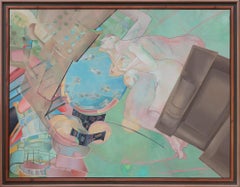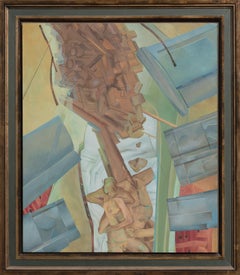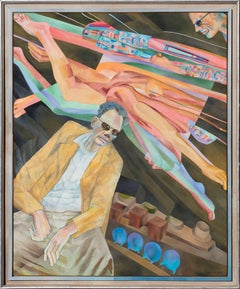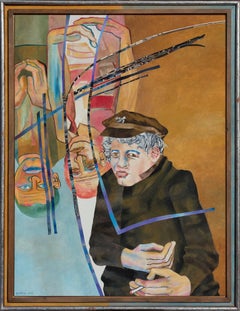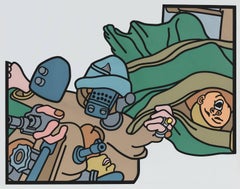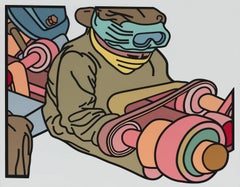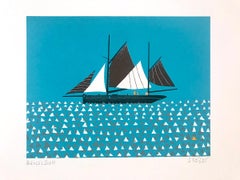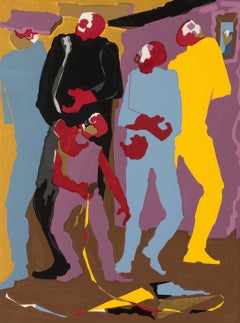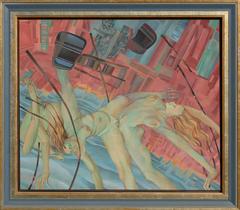Bernard Aptekar Art
to
14
10
10
10
4
4
For the Megaliths to the Megalopolis - Figurative Political Painting
By Bernard Aptekar
Located in New York, NY
Bernard Aptekar's For the Megaliths to the Megalopolis is a figurative painting measuring 49.5" x 65". Aptekar's paintings are often a political and social commentary of the contradi...
Category
Early 2000s Expressionist Bernard Aptekar Art
Materials
Canvas, Oil
The Speeding City Stretches Into Flesh - Figurative Painting with Pastel Colors
By Bernard Aptekar
Located in New York, NY
Aptekar's paintings are often a political and social commentary of the contradictions inherent to the human mankind. The surrealistic and expressionistic language used to covey the m...
Category
Early 2000s Expressionist Bernard Aptekar Art
Materials
Canvas, Oil
Arthur Miller Thinks - Expressionist Figurative Painting of Arthur Miller
By Bernard Aptekar
Located in New York, NY
Bernard Aptekar's Arthur Miller Thinks is a large 65.5 x 53.5 inches expressionist figurative oil painting. It portrays American playwright Arthur Miller. The main colors are blue, green, and pink. The surrealistic and expressionistic language used to covey the message, as well as the use of a palette with low contrast colors, has its roots in the work of Mexican muralist Diego Rivera, who Apterkar met at age of 11.
The outcome is an imagery of an extraordinary visual impact and absolutely unique to Aptekar's own creative process. Arthur Miller, the author of the play "Death of a Salesman...
Category
Early 2000s Expressionist Bernard Aptekar Art
Materials
Canvas, Oil
Joseph Heller Thinks About Catch-22 - Portrait Painting with Pastel Colors
By Bernard Aptekar
Located in New York, NY
Aptekar's paintings are often a political and social commentary of the contradictions inherent to the human mankind. The surrealistic and expressionistic language used to covey the message, as well as the use of a palette with low contrast colors like light blue, green and pink, has it's roots in the work of Mexican muralist Diego Rivera, who Apterkar met at age of 11.
The outcome is an imagery of an extraordinary visual impact and absolutely unique to Aptekar's own creative process. The title of this artwork "Joseph Heller...
Category
Early 2000s Expressionist Bernard Aptekar Art
Materials
Canvas, Oil
A Tough Citizen
By Bernard Aptekar
Located in New York, NY
As art historian and writer Suzanne Ramljak wrote "the ambivalent relationship between humanity and machinery has informed Aptekar's art from the start and remains a central theme in...
Category
1980s Expressionist Bernard Aptekar Art
Materials
Paper, Screen
Price Upon Request
Man Into Machine
By Bernard Aptekar
Located in New York, NY
As art historian and writer Suzanne Ramljak wrote "the ambivalent relationship between humanity and machinery has informed Aptekar's art from the start and remains a central theme in...
Category
1980s Expressionist Bernard Aptekar Art
Materials
Paper, Screen
Price Upon Request
A Piece of Technology
By Bernard Aptekar
Located in New York, NY
As art historian and writer Suzanne Ramljak wrote "the ambivalent relationship between humanity and machinery has informed Aptekar's art from the start and remains a central theme in...
Category
1980s Expressionist Bernard Aptekar Art
Materials
Screen
Price Upon Request
The Coffee Break
By Bernard Aptekar
Located in New York, NY
As art historian and writer Suzanne Ramljak wrote "the ambivalent relationship between humanity and machinery has informed Aptekar's art from the start and remains a central theme in his work. Like many of the issues Aptekar addresses, technology is not without contradiction."
The use of clear contours and colors, is certainly not oblivious of Fernand Leger latest work and what he called "the law of contrast". At the same time, the political and social commentary that are a constant inherent component of Aptekar's work has it's roots in the work of Mexican muralist Diego Rivera, who Apterkar met at age of 11.
The outcome is an imagery of an extraordinary visual impact and absolutely unique to Aptekar's own creative process.
This work "Coffee Break...
Category
1980s Expressionist Bernard Aptekar Art
Materials
Paper, Screen
Price Upon Request
They Won't Be Stopped
By Bernard Aptekar
Located in New York, NY
As art historian and writer Suzanne Ramljak wrote "the ambivalent relationship between humanity and machinery has informed Aptekar's art from the start and remains a central theme in...
Category
1980s Expressionist Bernard Aptekar Art
Materials
Paper, Screen
Price Upon Request
The Rats
By Bernard Aptekar
Located in New York, NY
As art historian and writer Suzanne Ramljak wrote "the ambivalent relationship between humanity and machinery has informed Aptekar's art from the start and remains a central theme in...
Category
1980s Expressionist Bernard Aptekar Art
Materials
Paper, Screen
Price Upon Request
The Hot Dog Man
By Bernard Aptekar
Located in New York, NY
As art historian and writer Suzanne Ramljak wrote "the ambivalent relationship between humanity and machinery has informed Aptekar's art from the start and remains a central theme in his work. Like many of the issues Aptekar addresses, technology is not without contradiction."
The shocking imagery of juxtaposed human and natural forms with mechanical elements, using clear contours and colors, is certainly not oblivious of Fernand Leger latest work and what he called "the law of contrast". At the same time, the political and social commentary that are a constant inherent component of Aptekar's work has it's roots in the work of Mexican muralist Diego Rivera, who Apterkar met at age of 11.
The outcome is an imagery of an extraordinary visual impact and absolutely unique to Aptekar's own creative process.
This work "The Hot Dog...
Category
1980s Expressionist Bernard Aptekar Art
Materials
Paper, Screen
Price Upon Request
The Football Players
By Bernard Aptekar
Located in New York, NY
As art historian and writer Suzanne Ramljak wrote "the ambivalent relationship between humanity and machinery has informed Aptekar's art from the start and remains a central theme in his work. Like many of the issues Aptekar addresses, technology is not without contradiction."
The shocking imagery of juxtaposed human and natural forms with mechanical elements, using clear contours and colors, is certainly not oblivious of Fernand Leger latest work and what he called "the law of contrast". At the same time, the political and social commentary that are a constant inherent component of Aptekar's work has it's roots in the work of Mexican muralist Diego Rivera, who Apterkar met at age of 11.
The outcome is an imagery of an extraordinary visual impact and absolutely unique to Aptekar's own creative process.
This work "The Football Players...
Category
1980s Expressionist Bernard Aptekar Art
Materials
Paper, Screen
Price Upon Request
Hand Into Meat
By Bernard Aptekar
Located in New York, NY
As art historian and writer Suzanne Ramljak wrote "the ambivalent relationship between humanity and machinery has informed Aptekar's art from the start and remains a central theme in...
Category
1980s Expressionist Bernard Aptekar Art
Materials
Paper, Screen
Price Upon Request
Moving Woman
By Bernard Aptekar
Located in New York, NY
As art historian and writer Suzanne Ramljak wrote "the ambivalent relationship between humanity and machinery has informed Aptekar's art from the start and remains a central theme in his work. Like many of the issues Aptekar addresses, technology is not without contradiction."
The shocking imagery of juxtaposed human and natural forms with mechanical elements, using clear contours and colors, is certainly not oblivious of Fernand Leger latest work and what he called "the law of contrast". At the same time, the political and social commentary that are a constant inherent component of Aptekar's work has it's roots in the work of Mexican muralist Diego Rivera, who Apterkar met at age of 11.
The outcome is an imagery of an extraordinary visual impact and absolutely unique to Aptekar's own creative process.
This work "Moving Woman" has been conceived while Aptekar was working on a monumental piece of 23 x 45 x 17 feet titled "The Defeat of the City of Plutonium: A Holocaust Prevented". The strong image of a human female naked body depicted as being one of the building parts...
Category
1980s Expressionist Bernard Aptekar Art
Materials
Paper, Screen
Price Upon Request
Related Items
Excelsior by Simon Tozer, Limited edition, Sailing, Landscape, Figurative art
By Simon Tozer
Located in Deddington, GB
Excelsior by Simon Tozer [2021]
limited_edition and hand signed by the artist
Screenprint on Paper
Edition number of 30
Image size: H:23 cm x W:30 cm
...
Category
21st Century and Contemporary Expressionist Bernard Aptekar Art
Materials
Paper, Screen
$131
H 13.78 in W 19.69 in D 0.04 in
Composition, Hiroshima, Jacob Lawrence
By Jacob Lawrence
Located in Southampton, NY
Silkscreen in eleven colors on vélin paper. Paper Size: 12.81 x 9.375 inches. Inscription: Unsigned and unnumbered, as issued. Notes: From the album, Hiroshima, 1983. Published by Th...
Category
1980s Expressionist Bernard Aptekar Art
Materials
Screen
$2,796 Sale Price
20% Off
H 12.81 in W 9.375 in
Young Woman Fetching Water oil on canvas painting Spain
Located in Barcelona, Barcelona
Title: Young Woman Fetching Water
Artist: Jesús Villar (1930–2015)
Medium: Oil on canvas
Dimensions: 39.4 x 20.1 in
Estimated date: c. 2000
Signature: Signed lower left: "Villar...
Category
Early 2000s Expressionist Bernard Aptekar Art
Materials
Canvas, Oil
$4,337 Sale Price
28% Off
H 39.38 in W 20.08 in
Four 1920's Russian Propaganda Posters by Alexander Apsit, Dmitri Moor & others
Located in Paonia, CO
The Bolshevik Era (1917-1921) was a life and death struggle for the Bolsheviks and their ideology. The propaganda poster was everywhere, as the Bolsheviks struggled to win the Civil War against the Whites and fought the Poles over control of the Ukraine and parts of modern day Belarus. The early Soviet poster - an incredible 3600 designs - was remarkable for its revolutionary fervor and biting wit. Powerful visual symbols were invented, like the red star and hammer and sickle.
These four posters are as follows:
1." May 1st All Russian Subbotnik " is a Russian poster promoting the first all Russian Subbotnik held on May 1st, 1920 in which Vladimir Lenin was in attendance. "Subbotnik" were weekend days of unpaid, volunteer community service work following the October Revolution which eventually became obligatory. By Russian artist Dmitry Moor
2. " Anniversary of Vsevobuch--Develop and Learn to Defend Freedom" celebrates the second anniversary of the implementation of universal military training and says ‘2nd Anniversary of Vsevobuch, Develop and Learn How To Defend Freedom. Artist unknown
3." Devil Doll " The Devil Doll' (January 1920) shows a soldier pointing his bayonet at a looming monster in the first panel. However, in the second it turns out to be the weak and insignificant enemies of the state behind a pathetic mask and cloak. Russian artist Dmitri Moor
4. " Forward to defend the Ural" ’By Russian artist A. Petroff ( pseudonym for Alexander Aspit ) from the ´´Plakate der Russichen Revolution 1917 - 1929´´
Dmitry Moor was a Russian graphic artist, poster designer and cartoonist, also known as D. Moor ("Д. Моор"). During the 1900s and 1910s he was a comic pioneer, making satirical comics ridiculing the Czarist regime and censorship. Under the Soviet regime he became one of the most celebrated propaganda artists. Both during the First and the Second World War he ridiculed the German army. In his work Moor often made use of sequential illustrated narratives or comics. He was the house cartoonist of magazines like Budilnik and later Bezbozhnik.
Alexander Petrovich Apsit was born in Riga on 25th March, 1880. He moved to Saint Petersburg in 1894 and attended art school and became a student of Lew Dmitriew-Kawkaski. Aspit worked for various Russian magazines and on the outbreak of the First World War was employed by the government to design war posters. After the Bolshevik Revolution Apsit was commissioned by the State Publishing House to design revolutionary posters.
Category
Early 20th Century Expressionist Bernard Aptekar Art
Materials
Screen
$1,240 Sale Price
20% Off
H 27.5 in W 19 in
Composition, Hiroshima, Jacob Lawrence
By Jacob Lawrence
Located in Southampton, NY
Silkscreen in eleven colors on vélin paper. Paper Size: 12.81 x 9.375 inches. Inscription: Unsigned and unnumbered, as issued. Notes: From the album, Hiroshima, 1983. Published by Th...
Category
1980s Expressionist Bernard Aptekar Art
Materials
Screen
$2,796 Sale Price
20% Off
H 12.81 in W 9.375 in
The fishmonger La Rambla Barcelona oil on canvas painting
By Manuel Capdevila Massana
Located in Barcelona, Barcelona
Unframed
Manuel Capdevila i Massana (Barcelona, December 28, 1910 - April 18, 2006) was a Catalan painter and goldsmith, son of the goldsmith Joaquín Capdevila y Meya and father o...
Category
1970s Expressionist Bernard Aptekar Art
Materials
Canvas, Oil
$925 Sale Price
57% Off
H 25.6 in W 31.89 in
The Bone of Contention, Bookmarks in the Pages of Life
By Betye Saar
Located in Southampton, NY
Silkscreen in colors and sepia-tones on Langdell fait à la main paper. Paper Size: 15 x 11 inches. Inscription: Unsigned and unnumbered, as issued. Notes: From the folio, Bookmarks i...
Category
Early 2000s Expressionist Bernard Aptekar Art
Materials
Screen
$4,796 Sale Price
20% Off
H 15 in W 11 in
Woman posing oil on canvas painting
Located in Barcelona, Barcelona
Technical Sheet
- Title: *The Secret in Her Eyes*
- Artist: Rosendo González Carbonell
- Technique: Oil on canvas
- Dimensions: 24 x 20 inches
- Framing: Unframed
- Style: Romantic realism...
Category
1980s Expressionist Bernard Aptekar Art
Materials
Canvas, Oil
$903 Sale Price
25% Off
H 24.02 in W 19.69 in
Detroit Institute of Arts (Two People - The Lonely Ones) Poster /// Edvard Munch
By Edvard Munch
Located in Saint Augustine, FL
Artist: (after) Edvard Munch (Norwegian, 1863-1944)
Title: "Detroit Institute of Arts (Two People - The Lonely Ones)"
Year: 1972
Medium: Original Screenprint, Exhibition Poster on sm...
Category
1970s Expressionist Bernard Aptekar Art
Materials
Screen
$750
H 36.32 in W 24.44 in
Composition, Poems of Léopold Sédar Senghor, Lois Mailou Jones
Located in Southampton, NY
Silkscreen on vélin paper. Paper Size: 22 x 17 inches. Inscription: Unsigned and unnumbered, as issued. Notes: From the album, Poems of Léopold Sédar Senghor, 1996. Published by The Limited Editions Club, New York; printed by Studio Heinrici, Ltd., New York, under the direction of Alexander Heinrici, New York, 1996. Excerpted from the album, CC examples of this album have been printed by Daniel Keleher at Wild Carrot Letterpress. This edition was designed and set in Bodoni types by Dan Cart and Julia Ferrari at Golgonooza Letter Foundry. The silkscreen prints were made by Alexander Heinrici at Studio Heinrici.
LOIS MAILOU JONES (1905-1998) was an African American artist and educator, often associated with the Harlem Renaissance. Jones was raised in Boston by working-class parents who emphasized the importance of education and hard work. After graduating from Boston’s School of the Museum of Fine Arts, Jones began designing textiles for several New York firms. She left in 1928 to take a teaching position at Palmer Memorial Institute in North Carolina. At Palmer, Jones founded the art department, coached basketball, taught folk dancing, and played the piano for Sunday services. Two years later, she was recruited by Howard University in Washington, D.C., to join its art department. From 1930–77, Jones trained several generations of African American artists, including David Driskell, Elizabeth Catlett, and Sylvia Snowden...
Category
1990s Expressionist Bernard Aptekar Art
Materials
Screen
$1,996 Sale Price
20% Off
H 22 in W 17 in
Maternity oil on canvas painting
Located in Barcelona, Barcelona
Title: Maternity
Artist: Jesús Villar (1930–2015)
Medium: Oil on canvas
Dimensions: 14.96 x 18.11 in
Framing: Unframed
Signature: Signed lower right: JVillar
Date: Circa 1980s
...
Category
1980s Expressionist Bernard Aptekar Art
Materials
Canvas, Oil
Now You Cookin' with Gas, Bookmarks in the Pages of Life
By Betye Saar
Located in Southampton, NY
Silkscreen in colors and sepia-tones on Langdell fait à la main paper. Paper Size: 15 x 11 inches. Inscription: Unsigned and unnumbered, as issued. Notes: From the folio, Bookmarks i...
Category
Early 2000s Expressionist Bernard Aptekar Art
Materials
Screen
$4,796 Sale Price
20% Off
H 15 in W 11 in
Previously Available Items
The City has a Body
By Bernard Aptekar
Located in New York, NY
This painting by Bernard Aptekar is part of a series of fourteen aerial cityscapes that the artist created. As art historian and writer Suzanne Ramljak wrote " they represent a comp...
Category
1990s Expressionist Bernard Aptekar Art
Materials
Canvas, Oil
Bernard Aptekar art for sale on 1stDibs.
Find a wide variety of authentic Bernard Aptekar art available for sale on 1stDibs. If you’re browsing the collection of art to introduce a pop of color in a neutral corner of your living room or bedroom, you can find work that includes elements of green, orange and other colors. You can also browse by medium to find art by Bernard Aptekar in screen print, paper, canvas and more. Much of the original work by this artist or collective was created during the 1980s and is mostly associated with the Expressionist style. Not every interior allows for large Bernard Aptekar art, so small editions measuring 34 inches across are available. Customers who are interested in this artist might also find the work of Alice Neel, Herve Telemaque, and Lovis Corinth. Bernard Aptekar art prices can differ depending upon medium, time period and other attributes. On 1stDibs, the price for these items starts at $3,100 and tops out at $32,000, while the average work can sell for $3,100.
